Magritte's Sunlit Period 1943- 1946
In may 1940 Magritte beset by martial problems and the Nazi invasion of Belgium left with a few close friends for France leaving Georgette behind. When he return to a Nazi occupied Brussels in October 1940 and reconciled with his beloved Georgette, his life was in shambles. Naturally melancholy, he became depressed. In 1943 to overcome the ambient despair of the war period, Magritte launches out in a type of painting inspired by impressionism in order to combine, through his personal research, the expression of the feelings of lightness, unconcern, happiness. The evocative titles are The First Day (Le Premier jour), The Harvest (La Moisson) and The Goad (L' Aiguinon).
His inspiration was by a reproduction of Pierre Auguste Renoir's Bathers. Pierre-Auguste Renoir (February 25, 1841–December 3, 1919) was a French artist who was a leading painter in the development of the Impressionist style, a celebrator of beauty, and especially feminine sensuality. Enticed by the sensuality of the colors, he opted for a more luminous palette. While continuing to draw objects and figures with the meticulous detail for which he was known, he added to them a touch clearly inspired by Impressionism, unleashing color in new, warmer and more cheerful tonalities. Magritte called this period his 'Sunlit' period. From March or April 1943, to the end of 1944 he produced about fifty pictures in this new style.
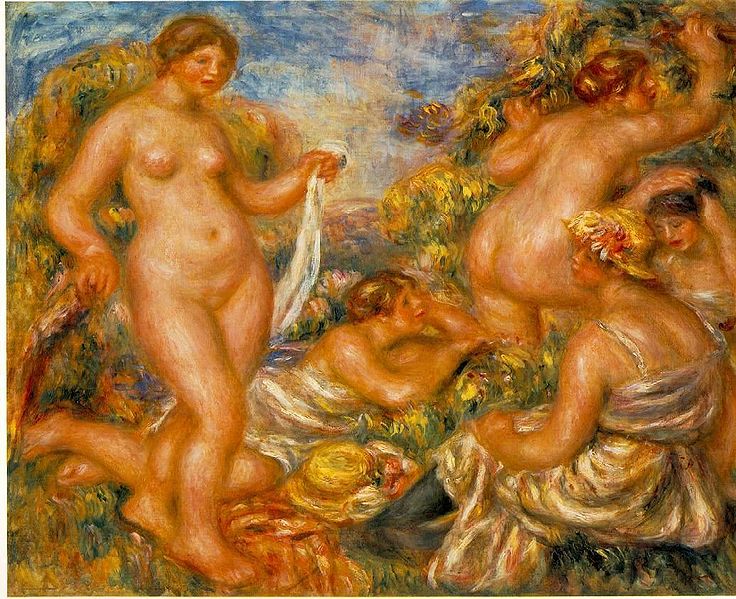
Renoir's "The Bathers" from 1918-19. This painting and other similar Renoir's triggered his Sunlit period.
Marcel Mariën elaborated on this work of Magritte:
Fired with enthusiasm, Magritte immediately went on to make other versions, including ‘The dance’ (a standing nude), and ‘The harvest’ (a reclining nude), and then concluded the experiment by taking the solution to its peak of refinement, since he performed the same transformation on Ingres’s La Source, an ‘academic’ representation if ever there was one, by not only adorning the young girl’s body with different colours, but by re-creating the whole picture according to the technique of the Impressionists! And Nougé, who had already supplied the titles for the previous versions, was to name this last experiment, the subversive profundity of which remains as usual unnoticed by everyone else: Monsieur Ingres’s good days.
Perhaps of more significance to the history of Belgian Surrealism, though, is that Marcel Marien was responsible for the first monograph on Magritte, published in 1943, and for the subsequent study on the artist, Les Corrections naturelles, which appeared in 1947. Marien also claimed that during this time because of the bleak economic times, painted forgeries of the works of other masters and that Marcel sold some of these paintings (the claim has not been documented).
In the 1940s Magritte again joined the communist party, which he had joined for the third time. Magritte's political involvement was based essentially upon his spirit of opposition. All of his poster designs were rejected on principle by the party leadership, and he could not bear having to subordinate his art to an ideological party line, even one so broadly conceived. "There is no more reason for art to be Walloon than for it to be vegetarian", was his reply to those seeking to enlist him for exhibitions aimed at demonstrating regionalist interests. Ultimately, his sole, his real banner was the mystery inherent in objects, in the world, that mystery which belongs to everyone and to no one.
September 1944: Brussels Liberated
The Belgium capital of Brussels was liberated by Allied forces on September 3, 1944. The Allies liberated the Belgium port of Antwerp, an important port. Magritte's Applied Dialectics (Lo Dialectique appliquee) 1944-1945 is one of the few paintings that directly deals with the war. Most of his paintings like his Treasure Island series use the symbolic war birds to imply German aggression.
The first three paintings are from the 1942 period, then it's clear his style has changed. In 1945 he began to do paintings in his old style as well. His manifesto Surrealism in full sunlight, which he concocted in 1946 with the complicity of Marcel Mariën, Paul Nougé, Louis Scutenaire, Joë Bousquet, Jacques Michel and Jacques Wergifosse, a prelude to the manifestoes of extramentalism and amentalism, is an instrument of warfare directed against the magic, esoteric ideology into which André Breton had strayed. “We have neither the time nor the taste to play at Surrealist art, we have a huge task ahead of us, we must imagine charming objects which will awaken what is left within us of the instinct to pleasure.”
The riff began when Magritte accompanied by Marcel Marien went to Paris in 1946 to meet with Breton to show his new work. Breton was not impressed and his close friend ELT Mesens didn't approve of his new "sunlit period" which Magritte argued was "the need in this post-war world to emgere from darkness." [Sylvester p. 208] Magritee added, "Against the general pessimism I uphold the quest for joy and pleasure."
Breton replied in a letter, "I can assure you that not one of your latest pictures gives me the impression of sunlight (Renir, yes)..." To justify his change in direction Magritte wrote "Le Sureallisme en plein soleil" and circulated the draft to various surrealists for support. Later in 1946 Breton published a list of the various surrealist painters and left Magritte off the list- he later listed Magritte as one of the "surrealists despite themselves."
Magritte Gallery 1943- 1946
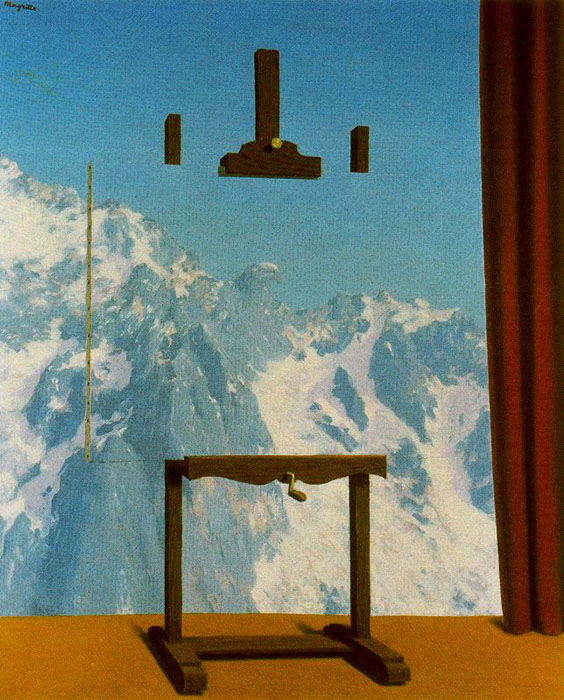
Call of Peaks (L'Appel des cimes) 1942-1943
This combines two of Magrite's favorite themes- the Fair Captive/Human Condition (easel with a painting) paintings and The Domain of Arnheim.
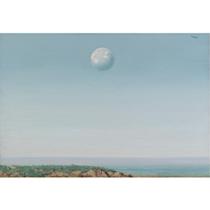
The Empire of the Reflection L'EMPIRE DE LA RÉFLEXION 1942-1943
Signed Magritte (upper right); signed Magritte and titled on the reverse; inscribed La Connaissance Naturelle on the stretcher; Oil on canvas Private Collection, Belgium (acquired from the above in 1959)
Magritte's enchanting L'Empire de la réflexion transposes two familiar elements – the globe and an evening landscape – to create a wholly uncanny image. The view of the earth rising at dusk over a barren plain calls to mind Ansel Adams' 1941 photograph, Moonrise, an image that captures the quiet beauty of the natural world (fig. 1). The captivating scene of L'Empire de la réflexion conveys that same sense of tranquility, albeit using a rather unsettling concept. Painted in the midst of the Second World War, Magritte presents us here with the improbable scenario of being removed from our planet, only to see it from an unreachable distance. Perhaps drawing from the uneasy tenor of the times, the artist questions our perception of the visible world, subverting the meanings that we attach to commonplace occurrences. The sense of mystification is amplified by the subtlety and almost photographic precision with which the earth and the horizon are depicted, triggering conflicting perceptions of the reality and impossibility of the scene we are witnessing. Writing about this sense of tranquility in Magritte's paintings, Roger Shattuck commented: "I know of no painting that conveys so totally the sense of a universe in suspense, a universe in which everything is waiting and nothing moves" (R. Shattuck, 'This is not René Magritte', in Artforum, New York, September 1966, p. 35).
According to the catalogue raisonné, the present work is related to an earlier composition from 1938 (Sylvester no. 462), in which the earth is seen rising above the sea. In the 1960s, the family of the present owner contacted Magritte about L'Empire de la réflexion, asking if he could elaborate on its precise meaning. Magritte's reply was just as enigmatic as this picture, exemplified by the following excerpt: "I can answer you by saying that I consider essential that which is given through inspiration: for example, the thought of a nocturnal landscape under a starlit sky. I have very little imagination, my painting owes nothing to imagination. Imagination only concerns the imaginary, which is to say the arbitrary, more or less paradoxical. I think unhesitatingly, that in order to paint in the way that I conceive painting, inspiration is necessary. In order to talk about what I paint, inspiration is also necessary, if one wishes really to talk about it."
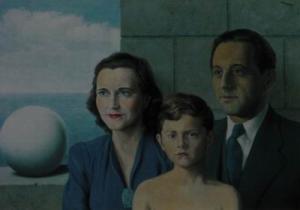
Portrait of the Giron Family- 1943
Robert Giron was Claude Spaak's cousin. Spaak met Magritte in the late 1920s (early 1930s) as manager of the Palais des Beaux Arts exhibits. Becasue of financila problems a department was organized named the Societe Auxiliaire des Expositions to manage the exhibitions for the Palais des Beaux Arts in the early 1930s. Fortunately for Magritte the three managers were Robet Giron, Claude Spaak, and his close friend and patron ELT Mesens.- all avid supporters of Magritte.
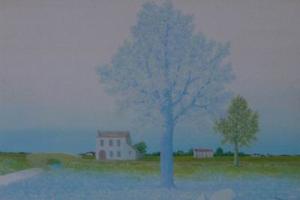
Penelope's Tapestry (La Tapisserie de Penelope) 1943
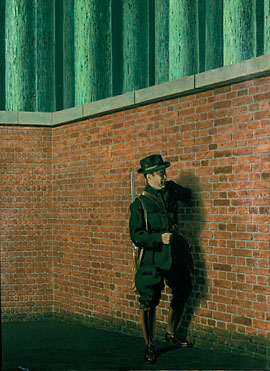
Universal Gravitation 1943 Dutch Title Universele zwaartekracht, De Year 1943 Format 100x73 cm Technique oil
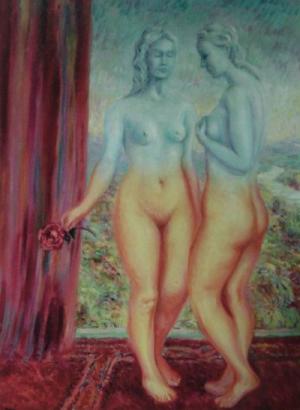
Felicity of Images also Friendship (Le Bonheur des images ou L'amitie) 1943, 51.2 x 38.2 in. / 130 x 97 cm
The Felicity of Images began Magritte's "Renoir" or "Sunlit" period. The nude on the left is a quote (copied from) of the nude in Renoir's 1918 Bathers (see above).
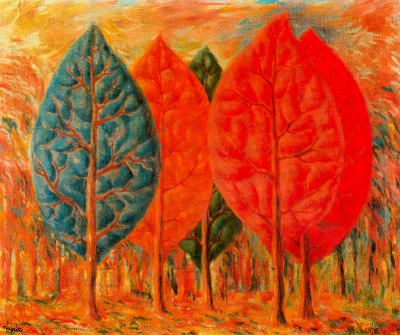
The Fire- 1943
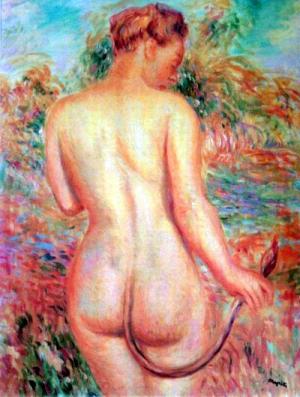
The Goad (L' Aiguinon) 1943
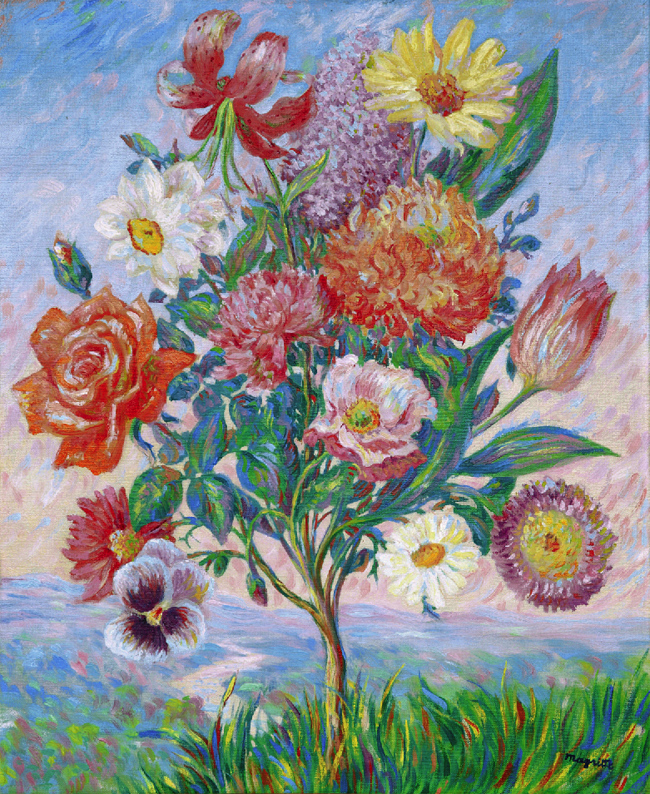
Premeditation (La Premeditation) 1943
%201943.jpg)
The Ocean (L'ocean) 1943
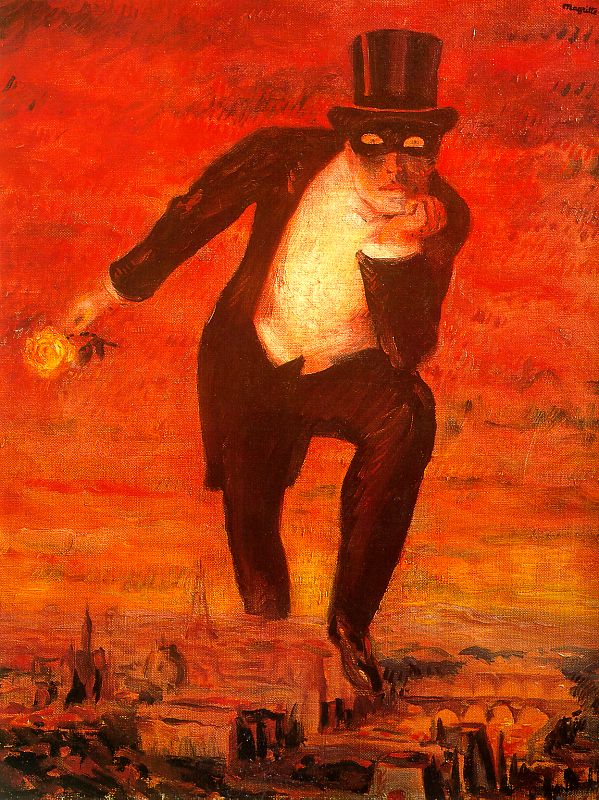
The Return of the Flame (le retour de la flame) 1943
This is taken from an actual Fantomas advertizement poster. Magritte uses his impressionistic style but the painting is essentially a copy, perhaps lending some creedence to Marcels Marien's claims that Magritte copied some works of art at this time. Fantomas was Magritte's alter-image and he featured him in several earlier paintings.
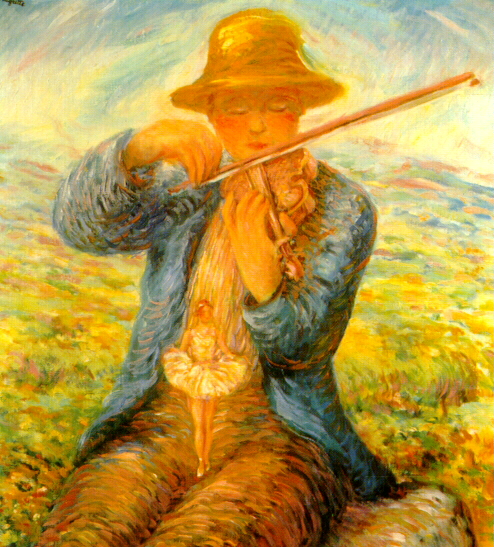
The First Day (Le Premier jour) 1943
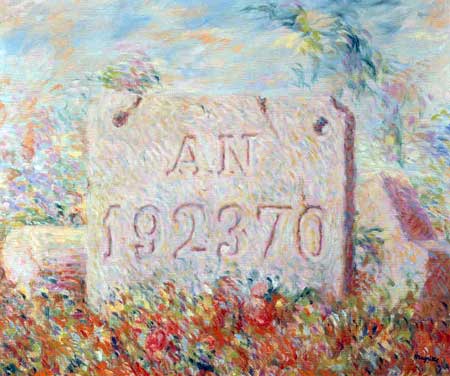
The Smile (Le Sourire) 1943
Magritte did another version of this in 1951. It depicts a tombstone with an enigmatic number on it- perhaps reflecting the high casulties of World War II. Magritte also did a varition of this theme titled "The Fountain of Youth."
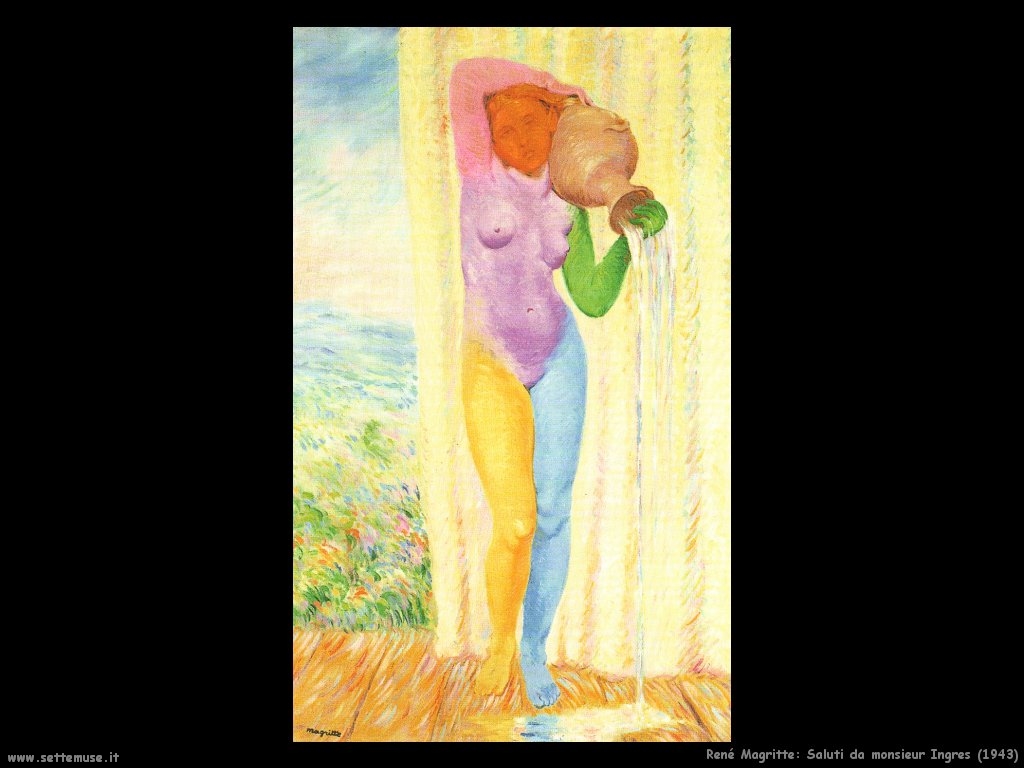
Monsieur Ingres' Good Days 1943
This is Magritte's tribute to Ingres's "La source," which was the painting Magritte liked best when he visited the Louve in 1923.
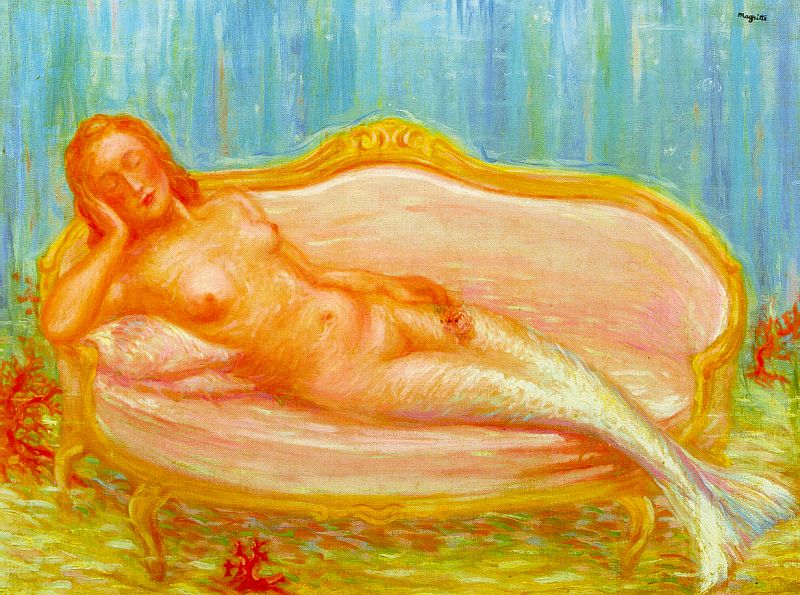
The Forbidden Universe 1943
Dutch Title: Verboden heelal, Het Year 1943 Format 68x81 cm Technique oil
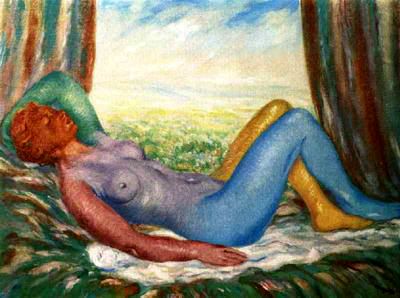
The Harvest (La Moisson) 1943, 23.6 x 31.5 in. / 60 x 80 cm
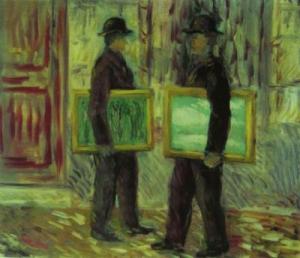
The Fifth Season (La Cinquième Saison) 1943
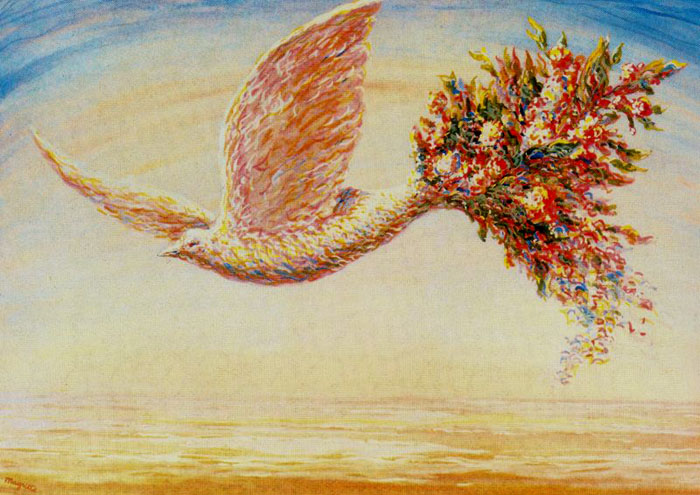
Favorable Omens 1944
The dove of peace and flowers of the "Plein soleil" period, the latter painted in vivid colours, should be interpreted as Magritte's anticipation of the approaching end to the Second World War. This work was a present for Georgette's sister.
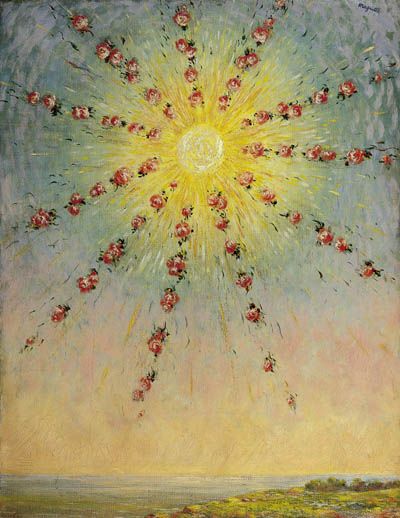
The Best Way (La Voie Royale) 1944
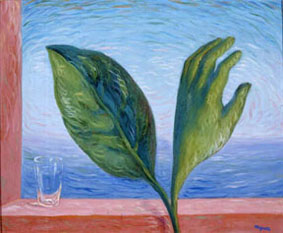
The Tempest II 1944
A completely different painting is titled "The Tempest" done in 1931.
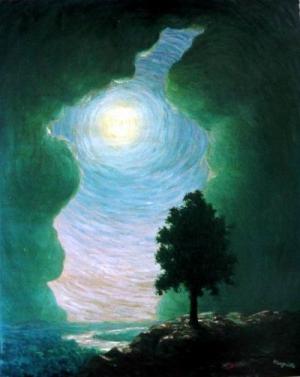
The Echo (L'Echo) 1944
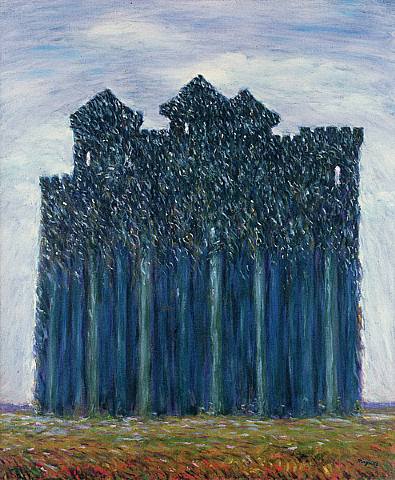
Elsinore (Elseneur) 1944
"Elsinore Castle" is the setting for much of William Shakespeare's famous tragedy Hamlet, Prince of Denmark. In this painting the forest forms the outline of the castle.
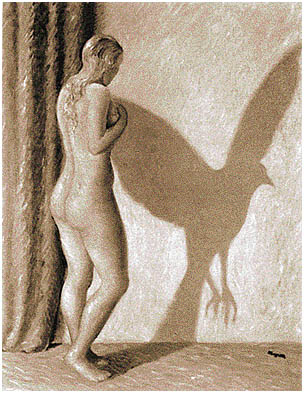
The Uncertainty Principle (Le Principe d'Incertitude) 1944
Before he painted this enigmatic painting in April 1944, Magritte described in a letter to his friend Marcel Mariën the image of a woman casting a shadow of a bird in flight. This, he said, would be the subject of his next painting: "An object (a human figure or something else) is presented against a background on which its shadow falls, with the amendment that he shadow is that of some quite different object. Example: a naked woman projecting another in the form of a bird onto a curtain." (quoted in D. Sylvester, op. cit., p. 334).
The titles for Magritte's paintings often had little to do with the subjects at hand and were usually derived from the creative suggestions of his friends. For this work, he appealed to Mariën for ideas, one of which was the title Free Will. After some consideration, Magritte wrote Mariën the following reply, which reveals the artist's own preferences: "As for Free Will, it is very good, but not absolutely convincing, (in the body of the relevant sentence, you unconsciously hit upon The Uncertainty Principle, and which is just as good). I would say that Free Will is rather abstract, I prefer The Uncertainty Principle, which has the merit of being totally abstract and yet, in spite of that, on the whole presents us with a disturbing aspect of actuality. Not that I like actuality, on the contrary, but it conveys a higher degree of temperature" (ibid.).
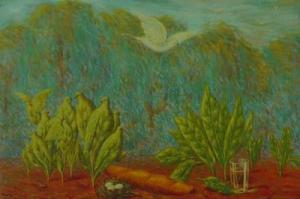
The Clearing (La Clairiere) 1944
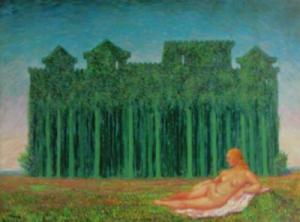
A Previous Life (La Vie anterieure) 1944, 23.6 x 31.9 in. / 60 x 81 cm
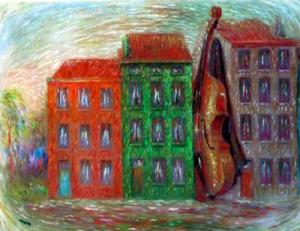
Image with a Green House (Image a la maison verte) 1944
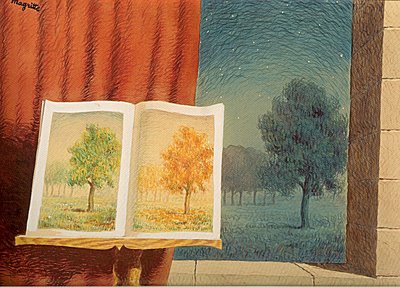
The Science of Dreams (Le science des Reves) gouache 1944
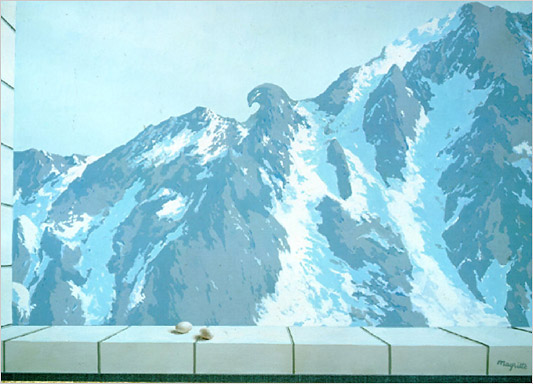
The Domain of Arnheim 1944 Gouche on paper
On of the many version of The Domain of Arnheim Magritte painted based on Edgar Allen Poe's story by the same name. The details are provided in the first version done in 1938 (see Brussels 1931-1942 Gallery).
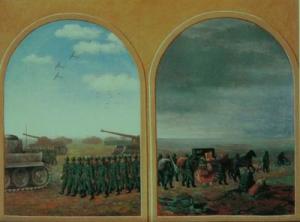
Applied Dialectics (Lo Dialectique appliquee) 1944-1945
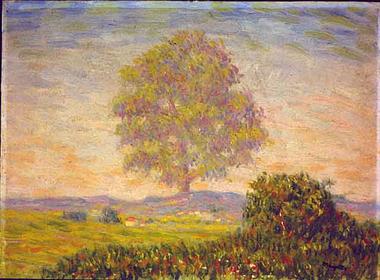
World Tour 1945
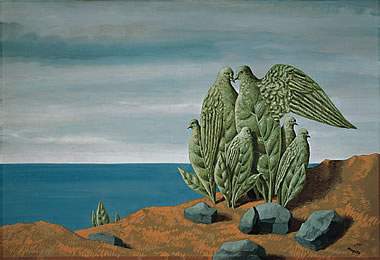
Treasure Island II 1945
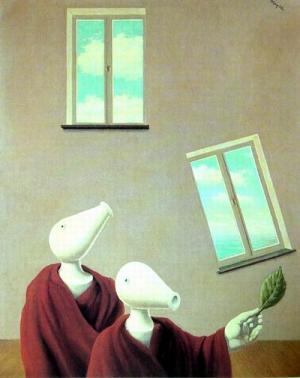
Natural Encounters- 1945
Artist Robert Gober's high windows are found in one of Magritte's lesser-known paintings, Natural Encounters (1945), which shows a pair of surreal figures (cicerones: which represent guides) standing in front of a wall pierced by two high casement windows revealing patches of blue sky. It looks like the window on the right has fallen magically and now is in a different position on the wall.
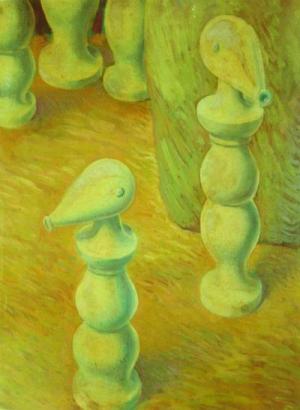
Fragment of a painting (Fragment d'une toile) 1945
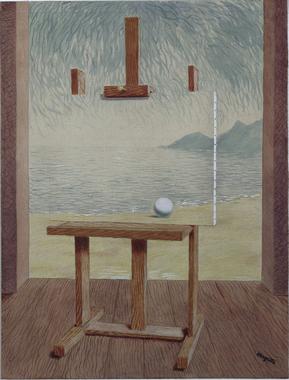
The Human Condition IV- 1945
This is the fourth The Human Condition version I have. It features a more impressionistic sky.
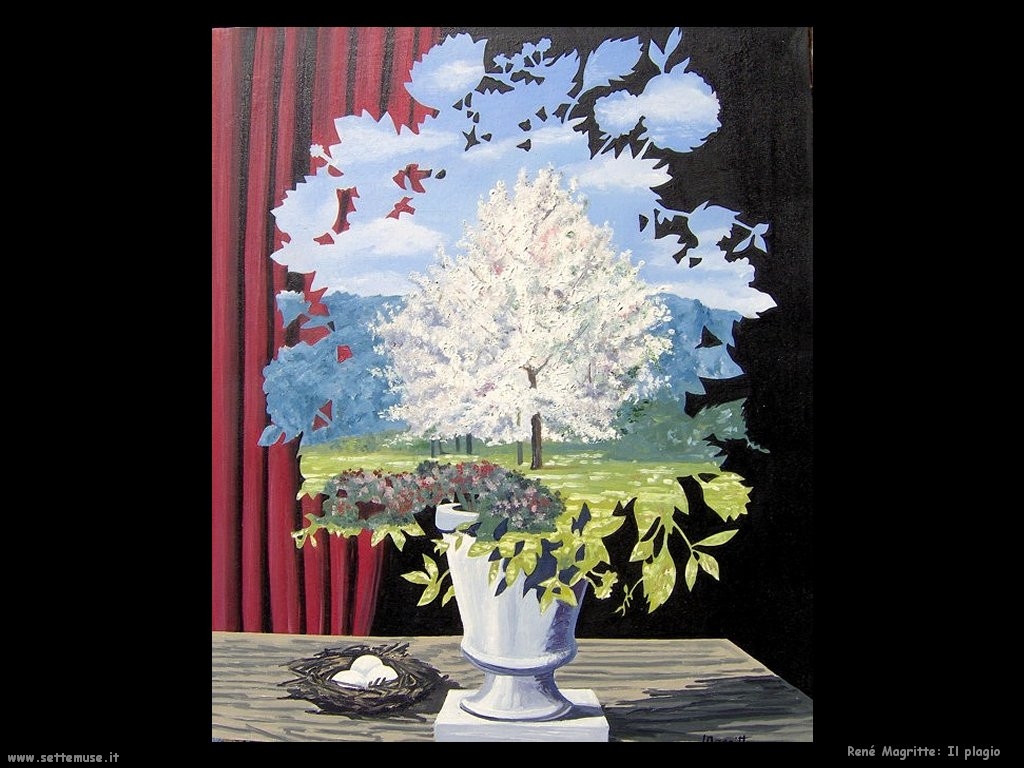
The Plagiarism II- 1945 Gouche
The first Le Plagiat was done circa 1940. Later versions use different titles.
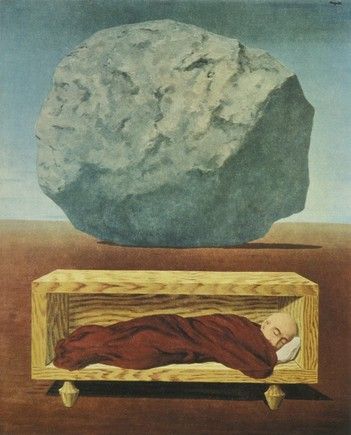
The Cape of the Tempests 1945
The same sleeper appears in an earlier painting, the 1927-1928 "Reckless Sleeper."
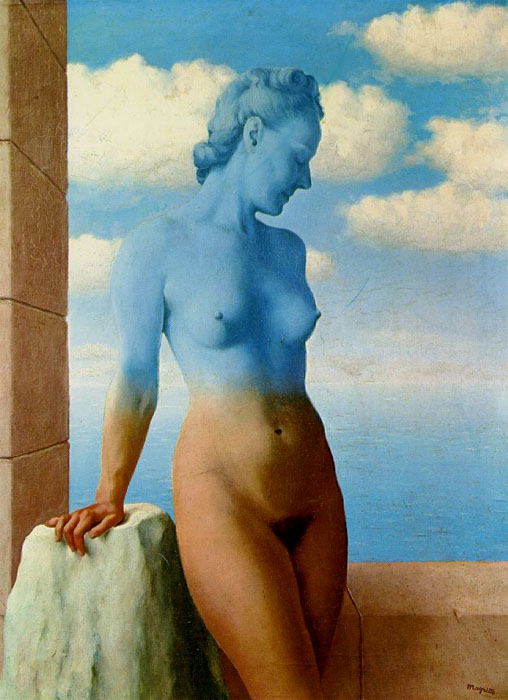
Black Magic (La magie noire), third version 1945, Oil on canvas 73 x 54 cm Private collection
One of Magritte's best nudes in my opinion and the best version of Black Magic. He painted several other versions (I have four images- the first was done in 1934) including some under a different titles (see "The Magnet" and also "The Dream" below). His painting of the lovely Georgette features her upper torso blending with the color of the sky, which I assume is the magic Rene is using.
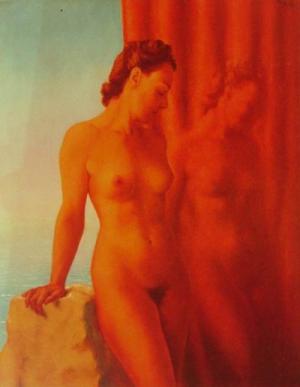
The Magnet- 1945
The Magnet is a variation of "Black Magic I" done in 1934. It's virtually the same pose as Black Magic III above done in 1945, the difference is the mysterious shadow image blended into the curtain. See another variation titled, The Dream below.
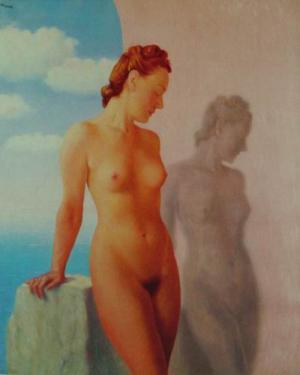
The Dream (La Reve) 1945
Another variation of "Black Magic I" done originally in 1934.
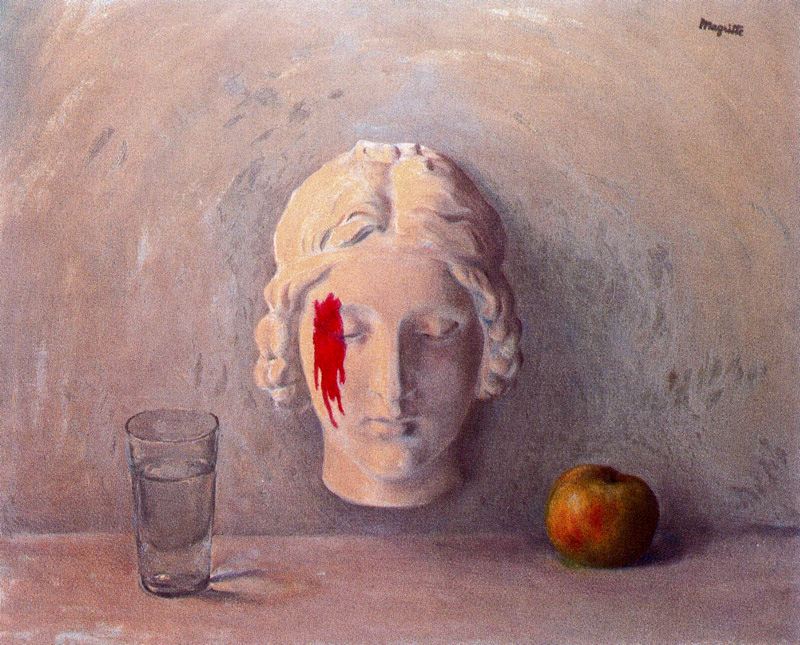
Memory 1945 (1938 ?)
Possibly the 1938 version (some list it as 1945), this is one of the early versions Magritte did. According to Sylvester this is one of "two (paintings) with plaster casts resembling the mythic death mask of an unknown girl drowned in the Seine."
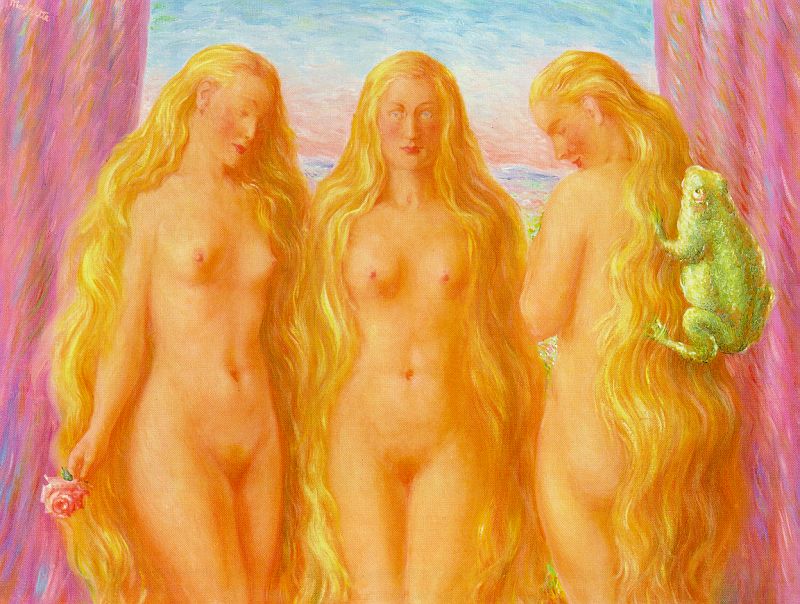
The Sea of Flames 1945-46 oil on canvas private collection
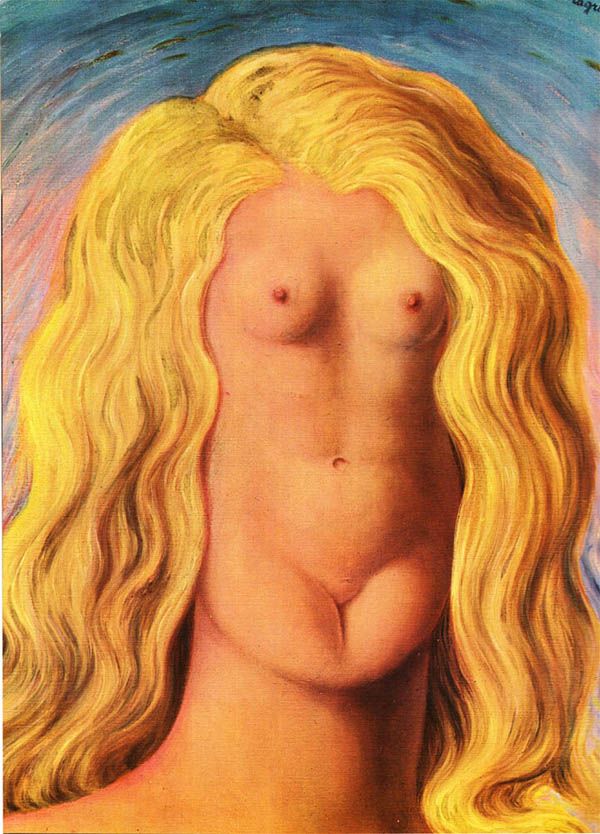
The Rape II or III 1945
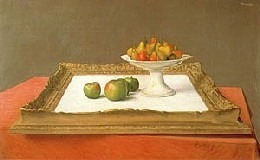
The Good Direction (Le Bon Sens) or possibly "Well Proportioned" 1945
At first glance this looks simply like a still life. The odd (askew) serving tray is really a blank canvas, while the fruit on the serving plate are made unusually small in porportion to the fruit on the canvas.
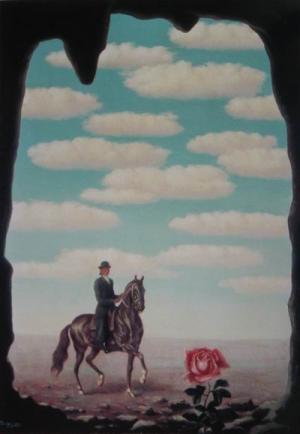
The Ivory Tower (La Tour d'ivoire) 1945
Here the rose takes on human characterististc much as in his 1953 painting Le Coup Au Cour.
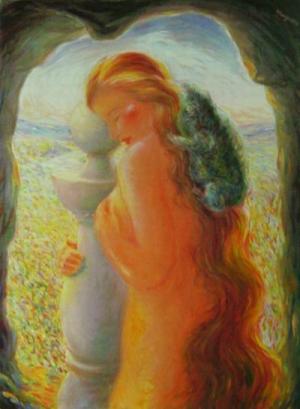
The Age of Pleasure (L’Âge du Plaisir) 1946
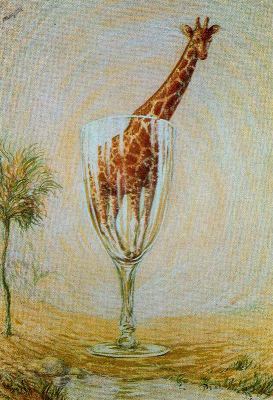
The Cut-Glass Bath, 1946 el bano de cristal
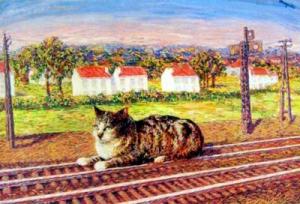
Raminagrobis-1946
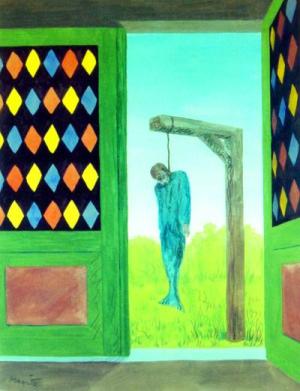
Merman Hanging from a Gibbet- 1946
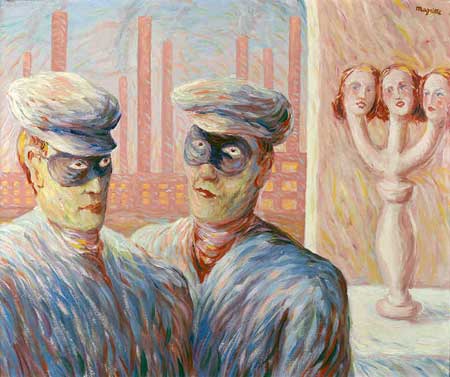
The Intelligence (L'Intelligence) 1946
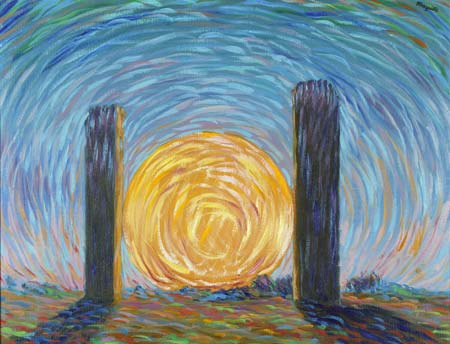
Thousand and One Nights (Les Mille et une Nuits) 1946
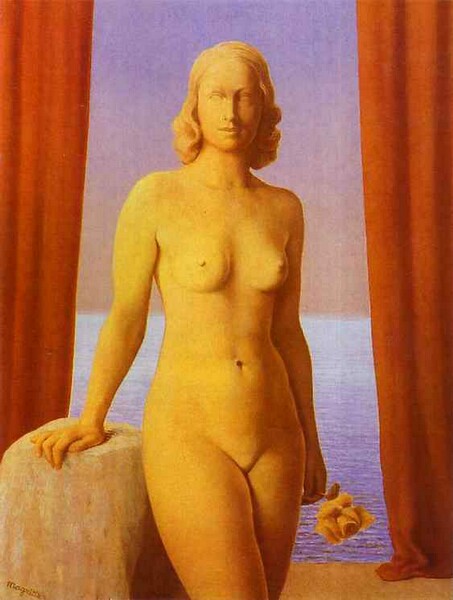
Flowers of Evil (Les Fluers du Mal) 1946. Oil on canvas. 80 x 60 cm. Private collection.
Flowers of Evil is part of the La Magie Noire (Black Magic) series of works Magritte executed beginning in 1934, depicting a female nude in an unidentified landscape. The model for this series was the artist's wife, Georgette Berger, and her image in the present picture is identical to the nude in Les Fleurs du mal (Sylvester no. 601) from that same year. Georgette is painted in a classical manner, with her figure abiding by the laws of beauty and proportion and resembling a marble sculpture as much as a live model. This traditional representation, however, is juxtaposed with the unexpected coloration of the figure, whose upper body gradually acquires the tone of the sky behind her. In nearly all paintings from this group, the woman has one hand resting on a block of stone. As Magritte himself proclaimed: "One idea is that stone is associated with an 'attachment' to the earth. It does not rise up of its own accord; you can rely on its remaining faithful to the earth's attraction. Woman, too, if you like. From another point of view the hard existence of stone (...) and the mental and physical system of a human being are not unconnected" (quoted in J. Meuris, René Magritte, London, 1988, p. 76).
The nude is always depicted either with her eyes closed, or with her head turned away from the viewer or, as in the present work, with blank eyes resembling those of a sculpture, thus becoming the object of the spectator's gaze and erotic desire. "Magritte said, in fact, that an undercurrent of eroticism was one of the reasons a painting might have for existing. It asserted itself most intensely and explicitly in these stately classical nudes with their cool coloring. For the very reason that it aims at maximum resemblance, their academicism is upset by the provocation of mystery emanating from that identification, once the painting and the arrangement of the painting interfere with its course. The prime example is Black Magic" (ibid., p. 76).
In a letter to Paul Nougé of January 1948, Magritte wrote on the subject of the present work as follows, "I am searching for a title for the picture of the nude woman (naked torso) in the room with the rock. One idea is that the stone is linked by some Affinity to the earth, it can't raise itself, we can rely on its generic fidelity to terrestrial attraction. The woman, too, if you like. From another point of view, the hard existence of the stone, well-defined, 'a hard feeling,' and the mental and physical system of a human being are not unconnected" (H. Torczyner, Magritte: Ideas and Images, New York, 1977, p. 173).
From "La Belle Captive: Magritte's Surrealism, Robbe-Grillet's Metafiction" by Ben Stoltzfus: "In Ecrits Complets Magritte describes The Flowers of Evil as "the statue of flesh of a naked woman holding a rose of flesh. The other hand leans on a stone. The open curtains reveal the sea and a summer sky" (175, my translation). In addition to the title of Baudelaire's book, the picture is an intertextual allusion to his poem entitled "Beauty": "I am beautiful, oh mortals! like a dream of stone" (41, my translation). The woman's body has a sensual reality but she is made of stone. She seems alive but her eyes are vacant. This movement back and forth between the true and the false, between living flesh and inanimate matter gives rise to an undecidability that is both mysterious and postmodern because the foregrounding of one possibility brackets the other one by putting it under erasure. From a Surrealist point of view, the body is marvelous and astonishing. From a postmodern point of view it is contradictory and its status is undecidable unless, of course, we suspend the voice of reason. But suspending reason is precisely what the Surrealists wanted us to do so that we could slip into a sensual dream world where everything is possible and in which even metal burns with a hot and living flame."
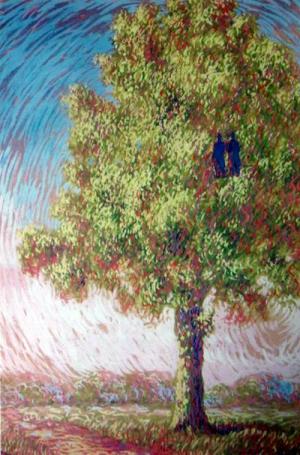
Reconnaissance without End (La Reconnaissance in finie) 1946, 22.8 x 15.6 in. / 58 x 39.6 cm
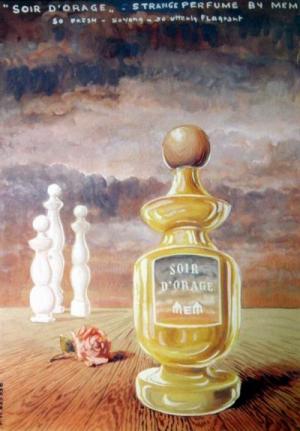
Soir d' orage- Perfume ad for Mem circa 1946
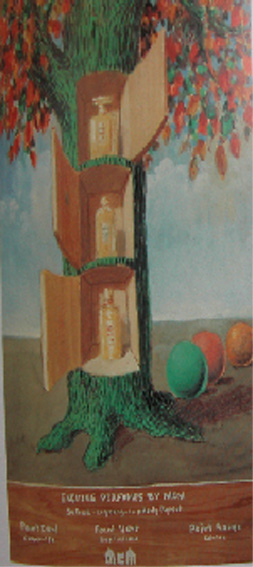
Mem Advertisment- 1946 Perfume add for Mem
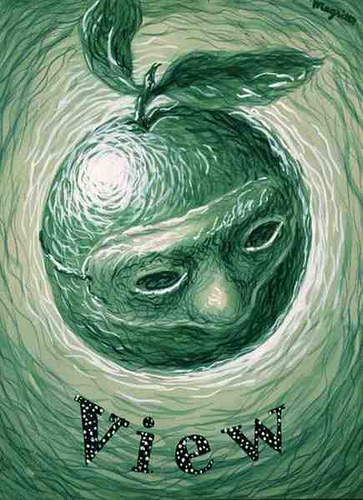
Cover of View Magazine 1946
The young American poet Charles Henri Ford started View magazine in his New York apartment in 1940. Ford's stay in Paris in the 1930's had introduced him to Surrealist poets and artists, including André Breton, the leader of that movement, who had encouraged the young poet. When Ford returned to the United States, he founded View as an avant-garde literary magazine with Surrealist interests. View magazine ran from September 1940 through March 1947, appearing quarterly and monthly as financial circumstances permitted. Ford initially intended View to be a journal of contemporary events compiled of writings by his literary friends in Europe. The magazine soon evolved beyond this news-oriented format to include color covers, additional advertisements, numerous illustrations, and more ambitious designs by Ford's assistant editor, Parker Tyler.
This is one of Magritte's first "apple with a mask" images that use used frequently in his The Married Priest paintings.
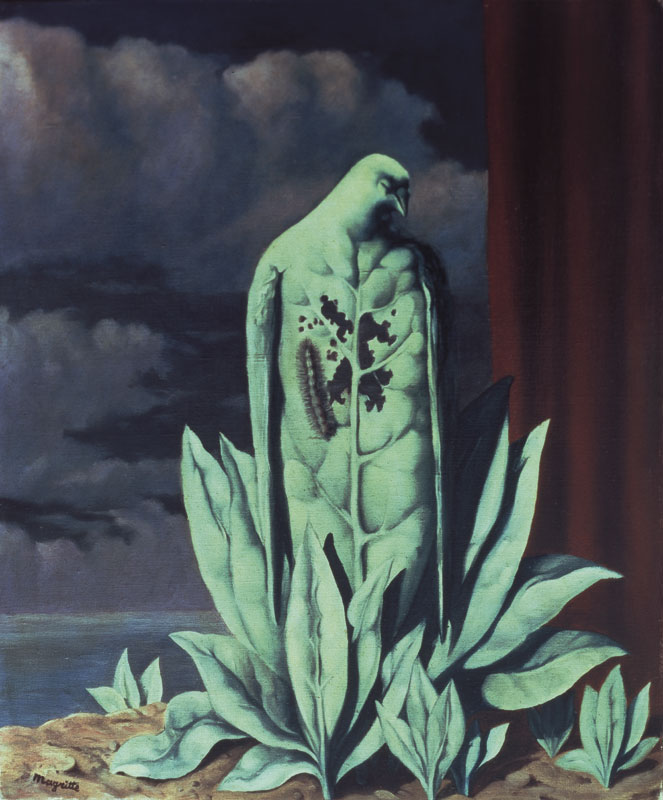
The Flavor of Tears (La Saveur des larmes) 1946, 20.1 x 14.6 in. / 51 x 37 cm
Magritte painted three versions of this painting of the war birds icon with a catepiller eating away the principle birds body. See below and versions in 1948 and 1949.
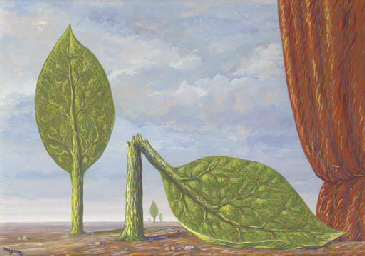
Flavor of Tears III (La saveur des larmes) 1946 signed 'Magritte' (lower left); signed, dated and inscribed '"La Saveur des Larmes" (III) Magritte 1946' (on the reverse) gouache on paper 13¾ x 19 3/8 in. (35 x 49.3 cm.)
Provenance: Galerie Dietrich, Brussels, acquired directly from the artist; Walter Schwarzenberg, Brussels, by whom certainly acquired from the above and thence by descent; Anonymous sale, Servarts, Brussels, 7 November 1995, lot 121.
Literature: René Magritte, 'Lettres à Paul Nougé', in Le Fait accompli, Brussels, 1974, no. 127-129 (partly obscured in installation photograph of the 1946 Dietrich exhibition). D. Sylvester (ed.), René Magritte, Catalogue Raisonné, vol. IV, Gouaches, Temperas, Watercolours and Papiers Collés 1918-1967, London, 1994, no. 1214 (illustrated p. 76).
Exhibited: Brussels, Galerie Dietrich, Exposition René Magritte, January 1946, no. 21. Brussels, Galeries Dietrich & Lou Cosyn, Exposition Magritte, April 1951, no. 25 (?).
Notes (from Christie's): Executed in 1946, La saveur des larmes is pervaded by a strange and bleak atmosphere wholly suited to Magritte's surreal vision. The blasted heath of the landscape is articulated only by a handful of leaf-trees. one of which has fallen, and the strange curtain at the side.
The leaf-tree was one of Magritte's most important Surreal motifs, emerging in the 1930s in La géante. Then, Magritte had sought to 'solve' the problems posed by various objects that we see around us, every day. His new-found code to deconstructing the world around us, and our perceptions of that world, involved such concise and eloquent visions as the egg in a cage, clouds on the ground, paintings before windows all-too-seamlessly presenting the world outside... In La saveur des larmes, these leaf-trees have been presented in juxtaposition to each other, emphasising the strangeness of their appearance, the impossible nature of this giant leaf with its broken trunk. Yet the weighty ambience of the landscape fills it with dignity and even tragedy. This is not a mere joke, but instead a revelation, a demand that we see the world around us in a new light. Indeed, with the strange curtain to the right of the image, Magritte is not only making a reference to the Old Masters, for instance by Vermeer, which incorporate a trompe-l'oeil curtain, but is also playing with the whole impression of space and wilderness within the picture. This desolate scene, devoid of human life, is discreetly punctured by a vast and impossible curtain. Magritte is thus playing with our perceptions, not only of trees, but also of the entire space within the picture. All the rules in Magritte's world beyond consciousness have been bent, but bent in a way that produces a unique and resonant poetry.